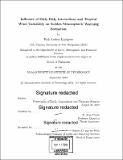| dc.contributor.advisor | R. Alan Plumb. | en_US |
| dc.contributor.author | Lindgren, Erik Anders | en_US |
| dc.contributor.other | Massachusetts Institute of Technology. Department of Earth, Atmospheric, and Planetary Sciences. | en_US |
| dc.date.accessioned | 2019-01-11T16:07:42Z | |
| dc.date.available | 2019-01-11T16:07:42Z | |
| dc.date.copyright | 2018 | en_US |
| dc.date.issued | 2018 | en_US |
| dc.identifier.uri | http://hdl.handle.net/1721.1/119987 | |
| dc.description | Thesis: Ph. D., Massachusetts Institute of Technology, Department of Earth, Atmospheric, and Planetary Sciences, 2018. | en_US |
| dc.description | Cataloged from PDF version of thesis. | en_US |
| dc.description | Includes bibliographical references (pages 139-143). | en_US |
| dc.description.abstract | This thesis investigates the effects of eddy-eddy interactions (EEI) and tropical wind variability on sudden stratospheric warming (SSW) formation in an idealized atmospheric GCM. Chapter 2 introduces a method to produce split and displacement SSWs in comparable amounts using either wavenumber 1 or 2 tropospheric heating perturbations. The results are compared to those obtained with wavenumber 2 topographic forcing. It is shown that the fraction of SSWs forced by anomalously strong tropospheric wave flux in the model is similar to that of SSWs in the observed atmosphere, but that the fractions for splits and displacements are different. Furthermore, a large fraction of SSWs occur without significant anomalous tropospheric wave flux, indicating that stratospheric transmission of climatological tropospheric wave flux plays an important role in SSW formation. Chapter 3 investigates the effects of EEI on SSW formation in the model by reproducing the model runs from Chapter 2 with EEI turned off in parts of the atmosphere. It is found that SSW frequencies can be strongly dependent on EEI throughout the atmosphere, but that EEI are required locally for splits and displacements to occur. Significant changes in SSW frequencies are obtained by turning off EEI locally, without changing the lower stratospheric wave forcing. Chapter 3 shows that while SSW formation can be considered a wave-mean flow interaction to first order, higher order processes are required to accurately reproduce both SSW frequencies and dynamics. The wavenumber 2 heating run used in Chapters 2 and 3 produce spontaneous tropical wind oscillations in the stratosphere. Chapter 4 identifies the source of these oscillations, and investigates the effects of the oscillations on the stratospheric polar vortex. Model runs with suppressed tropical wind variability are compared to the control run of Chapter 2. A slight increase in SSW frequency can be found in the model runs with suppressed tropical variability. It is found that upper stratospheric equatorial wind anomalies are strongly correlated with polar vortex strength, and hypothesized that westerly equatorial wind anomalies in the upper stratosphere can reinforce the conditions that lead to an anomalously strong polar vortex. A mechanism explaining this influence is presented. | en_US |
| dc.description.statementofresponsibility | by Erik Anders Lindgren. | en_US |
| dc.format.extent | 143 pages | en_US |
| dc.language.iso | eng | en_US |
| dc.publisher | Massachusetts Institute of Technology | en_US |
| dc.rights | MIT theses are protected by copyright. They may be viewed, downloaded, or printed from this source but further reproduction or distribution in any format is prohibited without written permission. | en_US |
| dc.rights.uri | http://dspace.mit.edu/handle/1721.1/7582 | en_US |
| dc.subject | Earth, Atmospheric, and Planetary Sciences. | en_US |
| dc.title | Influence of eddy-eddy interactions and tropical wind variability on sudden stratospheric warming formation | en_US |
| dc.title.alternative | Influence of EEI and tropical wind variability on sudden stratospheric warming formation | en_US |
| dc.type | Thesis | en_US |
| dc.description.degree | Ph. D. | en_US |
| dc.contributor.department | Massachusetts Institute of Technology. Department of Earth, Atmospheric, and Planetary Sciences | |
| dc.identifier.oclc | 1080936652 | en_US |
